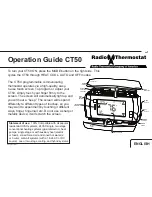
2
Switch No. 1- 5/2 DAY or 7 DAY.
When the switch is in the 7 DAY position each day may be programmed
with different switching times and temperatures. Placing the switch in
the 5/2 DAY position enables Monday to Friday to be programmed with
one set of switching times and temperatures, and Saturday and
Sunday to be programmed with a different set.
Switch No. 2 - OSC ON or OSC OFF
This is used to enable or disable the optimum start control (OSC)
function for event 1. To cater for different types of building construction
with differing fabric constants there are four start-up curves from which
to choose, (see the diagram over the page). These curves dictate how
long before event 1 the heating equipment will be switched on. The
selectable start-up durations are 0:00, 0:30, 1:00, 1:30 or 2:00 (2
hours). (Selecting 0 effectively disables the function).
Once initiated the difference between the space temperature and the
event 1 temperature is used to generate a pre-heat period proportional
to the OSC period selected. The closer the space temperature is to the
event 1 temperature, the shorter the pre-heat period. Refer to the
earlier section on Optimum Start Control for more detail.
It is recommended that the initial setting of the OSC is 30 minutes. See
the section on post-commissioning.
Switch No. 3 - CHRONO or ON/OFF
With this switch set to ON/OFF the TP75 will act as a conventional room
thermostat, switching the heating plant to maintain the programmed
temperature. When set to CHRONO the control function selected by
switch No. 4 is enabled.
IMPORTANT
. For systems with motorised zone valves ON/OFF mode
is recommended.
Switch No. 4 - Chrono 6 or Chrono 3
This switch configures the TP75-RF to control different forms of
heating system, typically as follows:
Use Chrono 3 for high thermal inertia systems, e.g. floor standing cast
iron boilers.
Use Chrono 6 for low thermal inertia systems, e.g. low water content
boilers and combi. boilers.
See the earlier section on Chrono-proportional Control for more detail.
5.
Position the slots in the top surface of the module over the lugs at the
top of the wallplate, and hinge downwards until the module is pressed
fully against the wallplate. Tighten the two screws from below to fix the
module to the wallplate.
6.
Before setting the programmes the unit and circuits should be checked.
Refer to the following Commissioning Instructions.
TP75-RF Installation
The TP75-RF is supplied with a wallplate for ease of mounting. The wallplate
is used solely for fixing the electronics module to the wall and contains no
terminals.
Fixing
Fig. 2 TP75-RF or TS2 location
1.
TP75-RF
Select the desired fixing position. (This should adhere
to normal room thermostat practice, see Fig. 2).
Fig. 3
Wallplate fixing clearances.
2.
When fixing the heating controller wallplate note that the terminals are
at the top and the vertical centre line of the heating controller is at the
right hand edge of the terminal 4 recess. Observe the clearance
required for fitting and removal, Fig. 3.
3.
Fix the wallplate to the wall.
4.
Before fixing the unit on to its wallplate, ensure that the four DIP
switches on the rear of the unit (see Fig. 4) have been moved to the
required settings; the choices are:-
7 day
OSC OFF
ON/OFF
Chrono 3
5/2 day
OSC ON
CHRONO
Chrono 6
Fig. 4
Factory pre-set DIP switch settings.
A B C 1 2 3 4 5 6
30mm min
Clearance for
screwdriver access
Wall or plaster
box mounting
holes
Aperture for
rear entry
Terminals
Knockouts for bottom
cable entry
Outline of unit






















